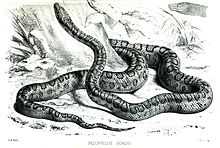Epicrates fordii
| Epicrates fordii | |
|---|---|
 | |
| illustration by G.H. Ford, for whom this species is named | |
| Scientific classification | |
| Kingdom: | Animalia |
| Phylum: | Chordata |
| Subphylum: | Vertebrata |
| Class: | Reptilia |
| Order: | Squamata |
| Suborder: | Serpentes |
| Family: | Boidae |
| Genus: | Epicrates |
| Species: | E. fordii |
| Binomial name | |
| Epicrates fordii (Günther, 1861) | |
| Synonyms | |
Epicrates fordii, known commonly as the Haitian ground boa, is a species of snake in the Boidae family.[3]
Geographic range
It is found in Hispaniola, Île de la Gonâve, Isla Saona, and Île à Cabrit in the Gulf of Gonâve.
Etymology
The specific name, fordii, is in honor of G.H. Ford, artist at the British Museum (Natural History), "whose merits in herpetology are well known by his truly artistical [sic] drawings."[4]
Description
Epicrates fordii is a medium-sized snake. Adults may attain a total length of 74 cm (29⅛ inches), which includes a tail 12.5 cm (4⅞ inches) long.
Dorsally it has a ground color that is pale olive, yellowish, or reddish, overlaid by a series of transverse dark brown blotches, which are oval or kidney-shaped, with blackish borders. Some of these blotches may merge to form a wide wavy stripe in some places. Ventrally it is yellowish, with small brown spots.
The smooth dorsal scales are arranged in 33-43 rows. Ventrals 250-265; anal plate entire; subcaudals 70-80 also entire.
On the dorsal surface of the head, the large frontal contacts the supraoculars; the remainder is covered by small irregular plates. There are 13 or 14 upper labials, without labial pits.[1]
Subspecies
Three subspecies are recognized, including the nominate race.
- Epicrates fordii fordii (Günther, 1861)
- Epicrates fordii agametus Sheplan & Schwartz, 1974
- Epicrates fordii manototus Schwartz, 1979
References
- ↑ 1.0 1.1 Boulenger, G.A. 1893. Catalogue of the Snakes in the British Museum (Natural History), Volume I., Containing the Families ... Boidæ ... London: Trustees of the British Museum (Natural History). (Taylor and Francis, printers). xiii + 448 pp. + Plates I.- XXVIII. (Epicrates fordii, p. 98).
- ↑ Schwartz, Albert, and Richard Thomas. 1975. Check-list of West Indian Amphibians and Reptiles. Special Publication No. 1. Pittsburgh, Pennsylvania: Carnegie Museum of Natural History. 216 pp. (Epicrates fordi, p. 184).
- ↑ "Epicrates". Integrated Taxonomic Information System. Retrieved August 11th, 2010.
- ↑ Günther, A. 1861. On a New Species of the Family Boidae. Proc. Zool. Soc. London 1861: 142 + Plate XXIII. (Pelophilus fordii)